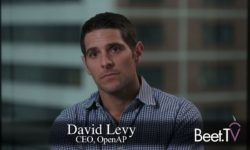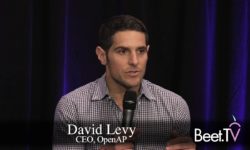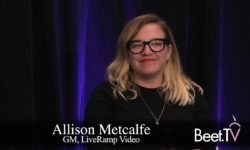Data + Math wasn’t looking to get acquired for $150 million – but it happened anyway.
In this video interview with Beet.TV, the CEO and co-founder of the TV advertising attribution vendor says, before its sale to LiveRamp earlier this year, the company was actually attempting a fundraising.
So, whilst LiveRamp is a friend with benefits for Data + Math, Hoctor views being part of the LiveRamp family as having funding for growth. Over the next year, he is planning two such growth points – first, becoming an automated currency for outcome-based ad guarantees and, second, international expansion.
“We really want to be viewed as a cross-screen currency that they can use to sell,” Hoctor tells Janus Strategy & Insights president Howard Shimmel for this Beet.TV interview. “The networks are doing more and more of this business, outcome-based guarantees. But, if you think about it, that’s more work than selling a Nielsen rating point. So the more we can automate it, make it easier, the more volume that they’ll drive.
“And then we’re definitely looking international to see where we could take Data + Math and launch it in other markets because the technology really can be applied to these other markets.”
A pixel for TV
Data + Math works when marketers add its “TV Pixel” to their websites or apps. The company links tracked in-app or on-web activity to ad exposure data from millions of US homes, effectively supporting attributing ad views to website or checkout conversion.
Wall Street Journal speculated that such marketing capabilities could be used in the 2020 US election cycle.
LiveRamp acquired Boston-based Data + Math, whose technology helps match up audience profiles and map ad exposure to conversion activities, after selling its former Acxiom Marketing Solutions (AMS) division to IPG for $2.3 billion.
Hoctor says Data + Math now benefits from LiveRam’s “identity” technology, which gains an understanding of consumer profiles in a fragmented world.
Crediting TV
For Hoctor, it’s all about helping TV prove its worth.
“I started Data + Math with my co-founder, Matt, with the thesis that TV was under-credited and, (therefore), undervalued,” he says.
“TV drives outcomes, but the fact that it’s separated from the purchase or that last click (means) credit is being gobbled up by the walled gardens and taken away from TV. I think a lot of advertisers would think of television as, ‘Oh, I do that for branding and then I do the other digital media for the outcomes, the final click’.
“The reality is, when you look at the data, you can see that TV will precede those clicks. If you see an ad six times on TV and then you do a Google search, shouldn’t TV be getting some credit?”
Driving outcomes
Hoctor lays out two examples of brands that can benefit from TV advertising that can demonstrate real outcomes:
- “If you are a mobile phone carrier, you’re trying to drive people to go to your website to sign up for a plan. Imagine measuring against that. You can do that. You can measure it and prove it to the marketer. They’ll gladly pay you to do that. That’s what they’re doing with the wall gardens.”
- “Or if you’re a quick serve restaurant, if you could really point to data that shows that running data-driven linear target at a particular audience will drive more people to go to your restaurant, they will pay you more money for it because they’re getting the outcomes that they want to get.”
This video was produced at the Beet Retreat leadership event hosted Publicis Media in New York. The event and video series is sponsored by FreeWheel and LiveRamp. For more videos from the event, please visit this page.














































